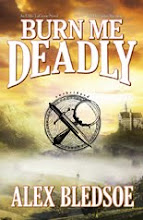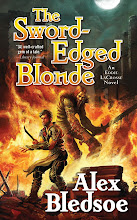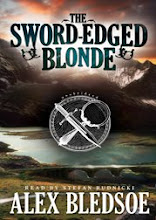Recently I got an e-mail from a reader that said, in part:
"Eddie LaCrosse with a girlfriend is not the same as Eddie LaCrosse wandering companionless through the world. The lonely but worldwise Eddie LaCrosse seems like a stronger character...Burn Me Deadly starts out great, but as soon as it went to the town scene with his girlfriend it lost something immediately (for me), and I think it was seeing him act like a wuss."
(quoted by permission.)
It got me thinking about why I wanted to give Eddie a romantic partner in Burn Me Deadly, and that made me consider Eddie's literary lineaage. I covered some of this back in June 2009, at a guest post on Erica Hayes' blog, but for this I want to focus a bit more on relationships.
Consensus agrees that Edgar Allen Poe invented the detective story with "The Purloined Letter" in 1844, and the hard-boiled detective was created by Dashiell Hammett in his "Continental Ops" stories and novels beginning in 1923. Poe's Auguste Dupin was, as most of his characters, mostly a cipher in service to the narrative, and while the Op definitely liked women, his job always came first. It wasn't until the appearance of Raymond Chandler's Philip Marlowe that the literary detective gained a full-blooded moral dimension in his relationships with women.

Marlowe, who first appeared by name in 1939's The Big Sleep, is cynical, disillusioned and fully aware of the world's evil. Yet he's also capable of comprehending innocence, both in the criminal sense and the moral. He sees the world for what it is, and remains aware of what it could be if the right people were ever put in charge. Marlowe also liked women, a lot, and wasn't shy about expressing it. But he seldom lowered his guard with one, and when he did he ended up regretting it.
Marlowe seems to be a confirmed bachelor, but Chandler actually married him off in his final novel Poodle Springs (unfinished at the time of his death in 1959). In 1989, the man considered Chandler's literary heir was asked to complete it; more on that to come.

Although Marlowe lived and worked through World War II, it took Ross MacDonald's Lew Archer to truly embody and explore the post-war world. Introduced in 1949's The Moving Target, Archer is considerably less witty than Marlowe, but he's also more overtly sympathetic. Marlowe could be dragged into cases he didn't want, but it was in his capacity as a detective; Archer gets pulled into things as a human being. Archer had once been married and occasionally connected with women from his cases, but never for long. Unlike Marlowe, who always saw the world's inadequacies as the impediment to love, Archer accepted that his own weaknesses were to blame.
When Raymond Chandler's estate searched for a contemporary author to take the four chapters of Poodle Springs and turn them into a finished novel, they chose Robert B. Parker. Parker's own Spenser novels combine Chandler's wit and Archer's empathy with a self-conscious literary element (Spenser is incredibly erudite and well-read). Since his first appearance in The Godwulf Manuscript in 1973, he has appeared roughly once a year in a series that is still going, if not exactly "strong," at least still capable of pleasant surprises (for example, 2005's Cold Service casts Spenser in the sidekick role in an adventure mainly involving his friend Hawk).

The biggest fundamental change Parker wrought on his predecessors was the addition of Susan Silverman in his second novel, God Save the Child. Susan becomes Spenser's long-term romantic partner, comfortably unmarried yet fully committed to the relationship (as is Spenser). With Susan, Spenser can drop his defenses and reveal his true feelings. But Susan has a deeper function as well: as a psychiatrist, she can give Spenser insights he might otherwise lack, often providing crucial psychological clues.
Eddie LaCrosse could have easily been a loner like Marlowe and Archer, forever mourning the one great love he lost. But in a lesson learned in part from Sam Peckinpah (see prior blog), I didn't want to make Eddie a rigid character; despite his world-weariness and seen-it-all cynicism, he's still capable of learning and changing. I also wanted to give him both someone to talk to, and someone who'd call him out on his mistakes.
I understand my reader's comment above, but I respectfully disagree with it. I don't think having a girlfriend makes Eddie a wuss. Believe me, there are days when I'd rather face big men with swords than work through issues with my wife. But that's as important a battle as anything fought with weapons, and I firmly believe that it makes Eddie (and me) a more interesting character.
(The title quote is from the strange, strange 1947 film adaptation of Chandler's novel The Lady in the Lake. Marlowe's response: "Only the ones in skirts.")

























































